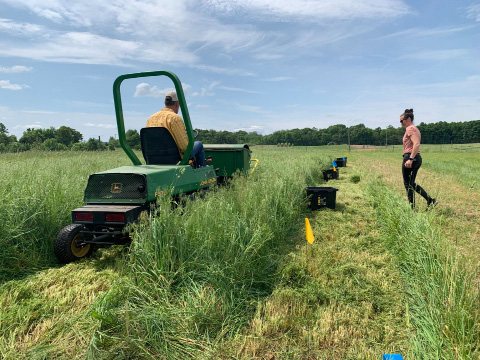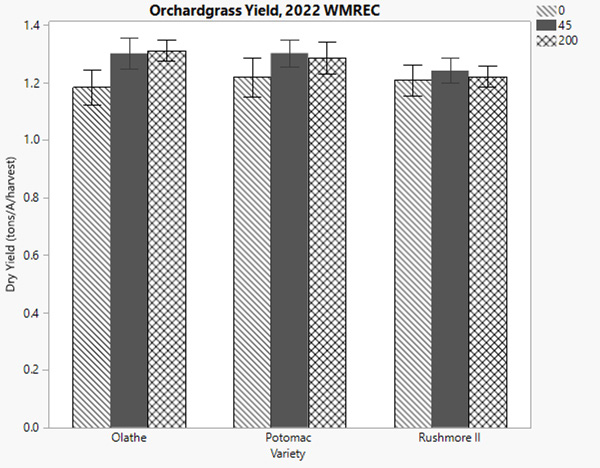Effect of Potash Fertility On Orchardgrass Yield
Andrew Kness, Senior Agriculture Agent | akness@umd.edu
Erika Crowl, Senior Agriculture Agent Associate
University of Maryland Extension

Orchardgrass is a popular pasture and hay forage species and it requires relatively high fertility levels, especially in a hay system where nutrients are being exported from the field. To test and demonstrate the importance of potash (potassium) fertility in orchargrass plantings, we established a replicated trial at the Western Maryland Research and Education Center. Three orchardgrass varieties were planted in a prepared seedbed at a seeding rate of 22 lbs pure live seed per acre using a drop-seeder on September 27, 2021. Plots were 6 feet wide by 20 feet long. Each variety received three fertility treatments: 1.) 0 lbs/A potash, 2.) 45 lbs/A potash (based on soil test), or 3.) 200 lbs/A potash, based on the potassium removal rate of 4 ton/A orchardgrass yield.
On March 23, 2022, 50 lbs/A nitrogen and 20 lbs/A phosphate (based on soil test) was top dressed to all plots. On April 8, 45 lbs/A potash (0-0-62) was top dressed on the 45 lb/A plots and 200 lb/A plots.
First cutting was done on May 23 using a small-plot forage harvester from the center 3 feet of each plot (Figure 1). Each plot was weighed and moisture subtracted to calculate dry yield. Following the first cutting, all plots received 50 lbs/A nitrogen in the form of urea and 75 lbs/A potash was top dressed on the 200 lbs/A plots.

Second cutting was performed on July 13 as described above, followed immediately by 50 lbs/A nitrogen. The third and final cutting was performed on September 16. Final fertilization of 80 lbs potash added to the 200 lbs/A plots and 50 lbs/A nitrogen was added to all plots on September 23.
Yield data was compiled and analyzed in JMP statistical software package, differences were separated using Fisher’s Least Significant Difference (α=0.10).
Interestingly, Potomac, an old variety, yielded significantly more (3.96 tons/A) than Olathe (3.65 tons/A) and Rushmore II (3.67 tons/A). In terms of fertility, plots that received 200 lbs/A potash yielded significantly more than those that received 0 and 45 lbs/A (Table 1).
We will continue this project in the coming years to collect more data and see how potassium fertility affects
persistence and yield over the long term.
This work was supported by the Maryland Horse Industry Board and the University of Maryland AgFS Program.
Special thanks to the Maryland Agriculture Experiment Station and the farm crew at the Western Maryland Research and Education Center.
